
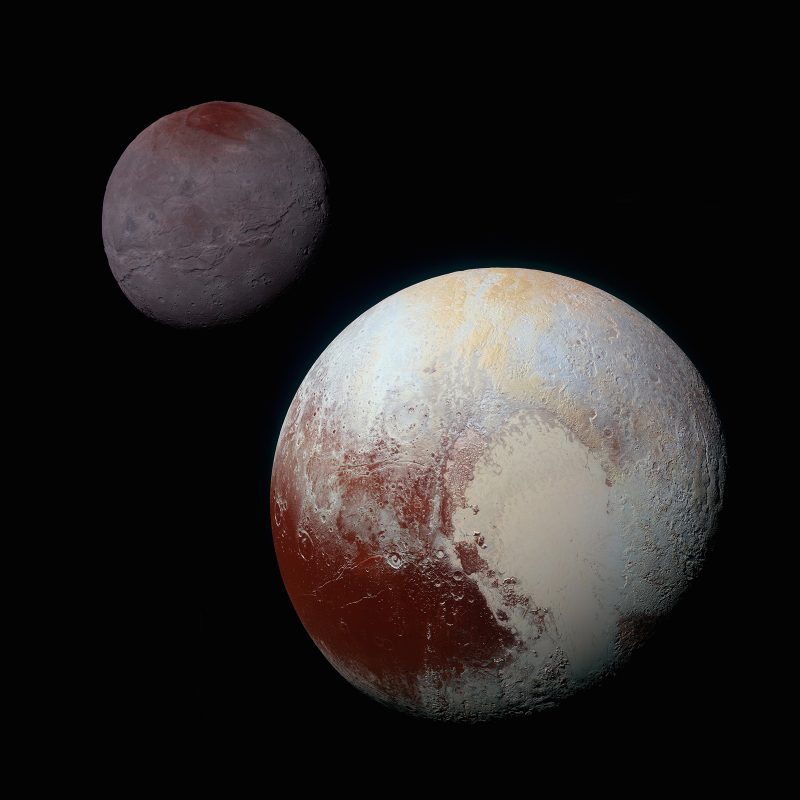
Mosaic image of Pluto and its largest moon Charon, captured around the time the New Horizons spacecraft swept closest to them on July 14, 2015. Image via NASA/ JHUAPL/ SwRI.
The year 2020 is exceptional for Jupiter and Pluto. These two worlds are having a triple conjunction this year. They’ll come together, move apart, and come together again three times in 2020. The first conjunction took place on April 5. The second one will come on June 30, and the final one on November 12. Because all of these Jupiter-Pluto conjunctions happen when these two planets are in our night sky (as opposed to being lost in the sun’s glare), this year’s Jupiter-Pluto alignment might be the best for centuries to come.
This year, very bright Jupiter and very faint Pluto will remain near each other throughout the year, closely aligned in front of the constellation Sagittarius. Pluto requires a telescope to be seen. No telescope? Try NASA’s Night Sky Network to find star parties and/or astronomy clubs near you.
And you don’t need a telescope to use your imagination. Throughout 2020, dazzling Jupiter will enable us to envision Pluto with the mind’s eye on the sky’s dome. First find Jupiter and – presto – you’ve nearly stumbled upon Pluto. Just remember, Jupiter outshines Pluto by several million times.
Where are these worlds now? Both rise into the southeast sky around nightfall or early evening in late June/early July 2020. Jupiter and Pluto climb upward throughout the evening hours, to reach the meridian roughly an hour after midnight, and then sit low in the southwest sky at daybreak.
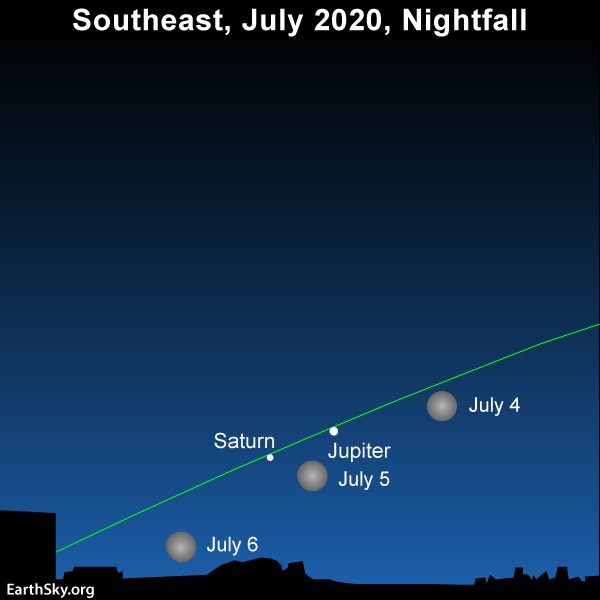
Jupiter and Pluto are in conjunction on June 30, 2020. Less than one week later, in early July 2020, the moon strolls by the king planet Jupiter, the dwarf planet Pluto, and the ringed planet Saturn. Pluto, although not shown on the above chart, is just a touch south of Jupiter on the sky’s dome. All these planets swing to opposition in July 2020: Jupiter (July 14), Pluto (July 15), Saturn (July 20). Read more.
Of course, although Jupiter and Pluto nearly align along the same line of sight throughout 2020, these two worlds aren’t close together in space. Jupiter is a bit more than 5 astronomical units (AU) from the sun, while Pluto lodges way beyond Jupiter, in the Kuiper Belt, at about 34 AU from the sun. One astronomical unit (AU) = one sun/Earth distance.
Jupiter’s and Pluto’s present distance in AU via Heavens-Above
Here’s some observational data about Pluto for 2020, from In-the-Sky.org
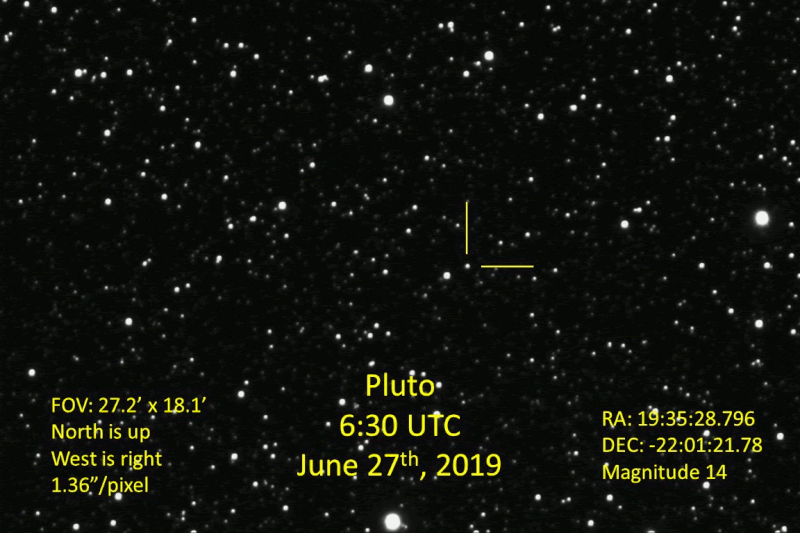
Steven Bellavia in Mattituck, New York, captured Pluto on 2 separate nights, June 24 and June 27, 2019. In this animated gif, you can see that Pluto moved in front of the stars between those 2 nights. Steven wrote: “Most of the motion you see is actually from the Earth, not Pluto, since our motion changes our perspective of the much-closer Pluto against the backdrop of the much-farther stars.” Thanks, Steven!
Two planets are said to be in conjunction whenever they reside north and south of one another on the sky’s dome. Conjunctions of Jupiter and Pluto recur in periods of 12 to 13 years. The previous Jupiter-Pluto conjunction happened on December 11, 2007, and the one before that on December 2, 1994. After 2020, the next Jupiter-Pluto conjunction will occur on February 4, 2033, and the one following that on April 12, 2045. But the gap between Jupiter and Pluto at each one of these conjunctions is quite far apart, and the conjunctions of 1994, 2007, and 2033 happen so close to the sun that even Jupiter is lost in the sun’s glare.
Far and away, 2020 presents the best alignment of Jupiter and Pluto in the 21st century (2001 to 2100). What’s more, Jupiter and Pluto stage three conjunctions this year, as Jupiter passes less than one degree north of Pluto at each conjunction on April 5, June 30 and November 12, 2020. (For reference, the moon’s angular diameter spans about 1/2 degree of sky.) All of these conjunctions in 2020 take place in front of the constellation Sagittarius, with Jupiter first passing Pluto on April 5 in prograde (going eastward in front of the backdrop stars), then sweeping past Pluto on June 30 in retrograde (going westward relative to the background stars), and then for the final Jupiter-Pluto conjunction on November 12 in prograde (eastward).
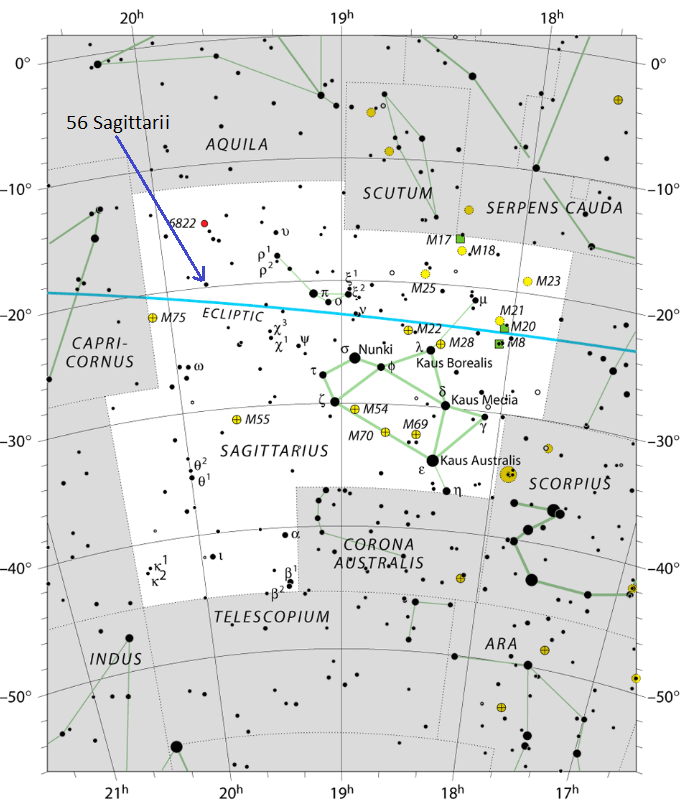
All three Jupiter-Saturn conjunctions on April 5, June 30 and November 12, 2020 take pace place in front of the constellation Sagittarius, not far from the 5th-magnitude star 56 Sagittarii. Constellation chart via International Astronomical Union (IAU).
Most of the time, a Jupiter-Pluto conjunction in any year is a solitary event, as Jupiter laps Pluto going eastward, and never looks back. Triple conjunctions of Jupiter and Pluto – which occur over a period of about 7.4 months – are rare because Jupiter has to first catch Pluto going prograde (eastward), then in retrograde (westward) and then in prograde (eastward) again. The three-peat performance last happened in 1955-56 (November 2, 1955; February 8 and June 16, 1956), and will next occur in 2106-07 (July 13 and November 2, 2106; February 19, 2107). Yet, all three conjunctions in 1955-56 were widely spaced, and all three conjunctions in 2106-07 will be widely spaced, too.
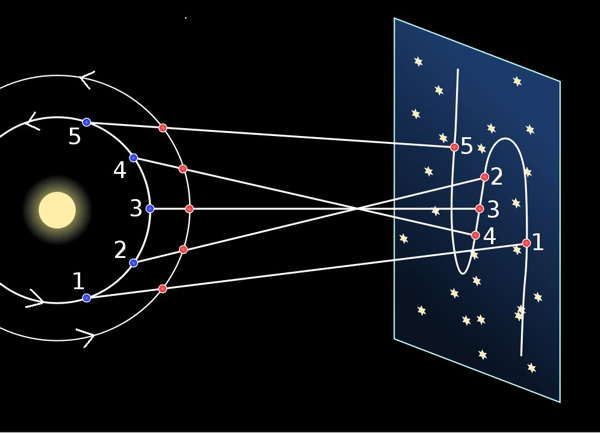
Illustration showing why a superior planet appears to go in retrograde (westward in front of the backdrop stars of the zodiac). As seen from the north side of the solar system, all the planets orbit counterclockwise. When the faster-moving Earth goes by a slower-moving superior planet, that planet appears to go backward (in retrograde). In 2020, Mars is in retrograde from September 9 to November 15, Jupiter from May 14 to September 13, and Saturn from May 11 to September 29. Image via Wikimedia Commons.
In other words, as we said above, 2020 may well showcase the best Jupiter-Pluto alignment for centuries to come. Most excitingly, both Jupiter and Pluto will reach opposition in mid-July 2020. At opposition, a superior planet – any planet revolving around the sun outside of Earth’s orbit – resides opposite the sun in Earth’s sky.
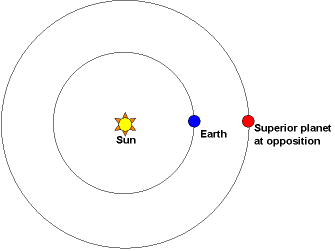
Opposition happens when Earth flies between a superior planet, like Mars, and the sun. This happens yearly for most of the outer planets (and every other year for Mars). Illustration via Heavens-Above.
At opposition, a superior planet (or superior dwarf planet) rises at sunset and sets at sunrise, and is out all night long. It’s at opposition that a planet shines at its brightest best in Earth’s sky, and it’s at or near opposition that a planet comes closest to Earth for the year.
Jupiter reaches opposition on July 14, 2020, at about 08:00 UTC, and comes closest to Earth on July 15, 2020, at about 10:00 UTC.
Pluto reaches opposition on July 15, 2020, at about 19:00 UTC, and comes closest to Earth on July 13, 2020, at about 09:00 UTC.
In an uncanny bit of timing, the oppositions of Jupiter and Pluto happen almost concurrently in mid-July 2020. A planet reaches opposition midway through a retrograde. However, since Pluto resides so much farther from the sun than Jupiter does, Pluto’s retrograde lasts nearly 1 1/2 months (six weeks) longer than Jupiter’s four-month retrograde. So for near-unison oppositions, Pluto’s retrograde has to start – and end – approximately three weeks before – and after – Jupiter’s retrograde.
Jupiter and Pluto retrograde/opposition in 2020
Jupiter begins retrograde: May 14, 2020, in front of the constellation Sagittarius
Jupiter at opposition: July 14, 2020, in front of the constellation Sagittarius
Jupiter ends retrograde: September 13, 2020, in front of the constellation SagittariusPluto begins retrograde: April 25, 2020, in front of the constellation Sagittarius
Pluto at opposition: July 15, 2020, in front of the constellation Sagittarius
Pluto ends retrograde: October 4, 2020, in front of the constellation Sagittarius
Jupiter-Pluto conjunction tables via Richard Nolle
Call it serendipity or synergy – or whatever – but the spectacular alignment of the king planet Jupiter with the dwarf planet Pluto doesn’t get much better than in 2020. A similarly good Jupiter-Pluto rendezvous might not happen again for a number of centuries to come.

Pluto as seen with a 12″ S/C telescope (14.3 mag.) on July 10, 2015. Photo by Efrain Morales of Sociedad de Astronomia del Caribe. More information about Pluto’s current location.
Bottom line: Jupiter is as easy to find as the dwarf planet Pluto is difficult. Jupiter is bright! It ranks as the fourth-brightest celestial object to light up the heavens, after the sun, moon and Venus. Pluto, on the other hand, is 1,600 times dimmer than the faintest star visible to the unaided eye. But Jupiter can help you find – or at least envision – Pluto this year. That’s because these two worlds are having a triple conjunction this year; they’re near each other on the sky’s dome all year and will come exceptionally close 3 times in 2020.
from EarthSky https://ift.tt/2XkisVG


Mosaic image of Pluto and its largest moon Charon, captured around the time the New Horizons spacecraft swept closest to them on July 14, 2015. Image via NASA/ JHUAPL/ SwRI.
The year 2020 is exceptional for Jupiter and Pluto. These two worlds are having a triple conjunction this year. They’ll come together, move apart, and come together again three times in 2020. The first conjunction took place on April 5. The second one will come on June 30, and the final one on November 12. Because all of these Jupiter-Pluto conjunctions happen when these two planets are in our night sky (as opposed to being lost in the sun’s glare), this year’s Jupiter-Pluto alignment might be the best for centuries to come.
This year, very bright Jupiter and very faint Pluto will remain near each other throughout the year, closely aligned in front of the constellation Sagittarius. Pluto requires a telescope to be seen. No telescope? Try NASA’s Night Sky Network to find star parties and/or astronomy clubs near you.
And you don’t need a telescope to use your imagination. Throughout 2020, dazzling Jupiter will enable us to envision Pluto with the mind’s eye on the sky’s dome. First find Jupiter and – presto – you’ve nearly stumbled upon Pluto. Just remember, Jupiter outshines Pluto by several million times.
Where are these worlds now? Both rise into the southeast sky around nightfall or early evening in late June/early July 2020. Jupiter and Pluto climb upward throughout the evening hours, to reach the meridian roughly an hour after midnight, and then sit low in the southwest sky at daybreak.

Jupiter and Pluto are in conjunction on June 30, 2020. Less than one week later, in early July 2020, the moon strolls by the king planet Jupiter, the dwarf planet Pluto, and the ringed planet Saturn. Pluto, although not shown on the above chart, is just a touch south of Jupiter on the sky’s dome. All these planets swing to opposition in July 2020: Jupiter (July 14), Pluto (July 15), Saturn (July 20). Read more.
Of course, although Jupiter and Pluto nearly align along the same line of sight throughout 2020, these two worlds aren’t close together in space. Jupiter is a bit more than 5 astronomical units (AU) from the sun, while Pluto lodges way beyond Jupiter, in the Kuiper Belt, at about 34 AU from the sun. One astronomical unit (AU) = one sun/Earth distance.
Jupiter’s and Pluto’s present distance in AU via Heavens-Above
Here’s some observational data about Pluto for 2020, from In-the-Sky.org

Steven Bellavia in Mattituck, New York, captured Pluto on 2 separate nights, June 24 and June 27, 2019. In this animated gif, you can see that Pluto moved in front of the stars between those 2 nights. Steven wrote: “Most of the motion you see is actually from the Earth, not Pluto, since our motion changes our perspective of the much-closer Pluto against the backdrop of the much-farther stars.” Thanks, Steven!
Two planets are said to be in conjunction whenever they reside north and south of one another on the sky’s dome. Conjunctions of Jupiter and Pluto recur in periods of 12 to 13 years. The previous Jupiter-Pluto conjunction happened on December 11, 2007, and the one before that on December 2, 1994. After 2020, the next Jupiter-Pluto conjunction will occur on February 4, 2033, and the one following that on April 12, 2045. But the gap between Jupiter and Pluto at each one of these conjunctions is quite far apart, and the conjunctions of 1994, 2007, and 2033 happen so close to the sun that even Jupiter is lost in the sun’s glare.
Far and away, 2020 presents the best alignment of Jupiter and Pluto in the 21st century (2001 to 2100). What’s more, Jupiter and Pluto stage three conjunctions this year, as Jupiter passes less than one degree north of Pluto at each conjunction on April 5, June 30 and November 12, 2020. (For reference, the moon’s angular diameter spans about 1/2 degree of sky.) All of these conjunctions in 2020 take place in front of the constellation Sagittarius, with Jupiter first passing Pluto on April 5 in prograde (going eastward in front of the backdrop stars), then sweeping past Pluto on June 30 in retrograde (going westward relative to the background stars), and then for the final Jupiter-Pluto conjunction on November 12 in prograde (eastward).

All three Jupiter-Saturn conjunctions on April 5, June 30 and November 12, 2020 take pace place in front of the constellation Sagittarius, not far from the 5th-magnitude star 56 Sagittarii. Constellation chart via International Astronomical Union (IAU).
Most of the time, a Jupiter-Pluto conjunction in any year is a solitary event, as Jupiter laps Pluto going eastward, and never looks back. Triple conjunctions of Jupiter and Pluto – which occur over a period of about 7.4 months – are rare because Jupiter has to first catch Pluto going prograde (eastward), then in retrograde (westward) and then in prograde (eastward) again. The three-peat performance last happened in 1955-56 (November 2, 1955; February 8 and June 16, 1956), and will next occur in 2106-07 (July 13 and November 2, 2106; February 19, 2107). Yet, all three conjunctions in 1955-56 were widely spaced, and all three conjunctions in 2106-07 will be widely spaced, too.

Illustration showing why a superior planet appears to go in retrograde (westward in front of the backdrop stars of the zodiac). As seen from the north side of the solar system, all the planets orbit counterclockwise. When the faster-moving Earth goes by a slower-moving superior planet, that planet appears to go backward (in retrograde). In 2020, Mars is in retrograde from September 9 to November 15, Jupiter from May 14 to September 13, and Saturn from May 11 to September 29. Image via Wikimedia Commons.
In other words, as we said above, 2020 may well showcase the best Jupiter-Pluto alignment for centuries to come. Most excitingly, both Jupiter and Pluto will reach opposition in mid-July 2020. At opposition, a superior planet – any planet revolving around the sun outside of Earth’s orbit – resides opposite the sun in Earth’s sky.

Opposition happens when Earth flies between a superior planet, like Mars, and the sun. This happens yearly for most of the outer planets (and every other year for Mars). Illustration via Heavens-Above.
At opposition, a superior planet (or superior dwarf planet) rises at sunset and sets at sunrise, and is out all night long. It’s at opposition that a planet shines at its brightest best in Earth’s sky, and it’s at or near opposition that a planet comes closest to Earth for the year.
Jupiter reaches opposition on July 14, 2020, at about 08:00 UTC, and comes closest to Earth on July 15, 2020, at about 10:00 UTC.
Pluto reaches opposition on July 15, 2020, at about 19:00 UTC, and comes closest to Earth on July 13, 2020, at about 09:00 UTC.
In an uncanny bit of timing, the oppositions of Jupiter and Pluto happen almost concurrently in mid-July 2020. A planet reaches opposition midway through a retrograde. However, since Pluto resides so much farther from the sun than Jupiter does, Pluto’s retrograde lasts nearly 1 1/2 months (six weeks) longer than Jupiter’s four-month retrograde. So for near-unison oppositions, Pluto’s retrograde has to start – and end – approximately three weeks before – and after – Jupiter’s retrograde.
Jupiter and Pluto retrograde/opposition in 2020
Jupiter begins retrograde: May 14, 2020, in front of the constellation Sagittarius
Jupiter at opposition: July 14, 2020, in front of the constellation Sagittarius
Jupiter ends retrograde: September 13, 2020, in front of the constellation SagittariusPluto begins retrograde: April 25, 2020, in front of the constellation Sagittarius
Pluto at opposition: July 15, 2020, in front of the constellation Sagittarius
Pluto ends retrograde: October 4, 2020, in front of the constellation Sagittarius
Jupiter-Pluto conjunction tables via Richard Nolle
Call it serendipity or synergy – or whatever – but the spectacular alignment of the king planet Jupiter with the dwarf planet Pluto doesn’t get much better than in 2020. A similarly good Jupiter-Pluto rendezvous might not happen again for a number of centuries to come.

Pluto as seen with a 12″ S/C telescope (14.3 mag.) on July 10, 2015. Photo by Efrain Morales of Sociedad de Astronomia del Caribe. More information about Pluto’s current location.
Bottom line: Jupiter is as easy to find as the dwarf planet Pluto is difficult. Jupiter is bright! It ranks as the fourth-brightest celestial object to light up the heavens, after the sun, moon and Venus. Pluto, on the other hand, is 1,600 times dimmer than the faintest star visible to the unaided eye. But Jupiter can help you find – or at least envision – Pluto this year. That’s because these two worlds are having a triple conjunction this year; they’re near each other on the sky’s dome all year and will come exceptionally close 3 times in 2020.
from EarthSky https://ift.tt/2XkisVG

Aucun commentaire:
Enregistrer un commentaire